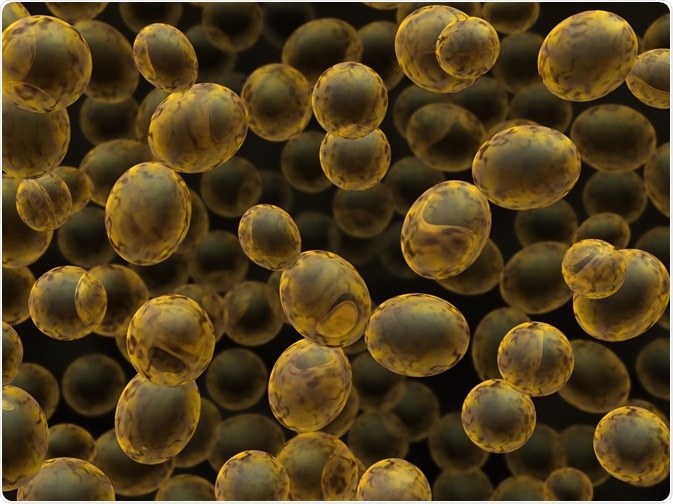Researchers have successfully recreated the entire biosynthetic pathway for a range of major cannabinoids – including TCH and CBD in the yeast Saccharomyces cerevisiae. Manipulation of gene expression and enzyme promiscuity enabled the team to alter both the flux and activities of several pathways to produce both standard cannabinoids and rare analogs.
Notably, the team – led by Professor Kealing – demonstrated their techniques compatibility with synthetic chemistry approaches, demonstrating the potential pool of cannabinoid precursors from which to investigate as potential therapeutic treatments.
 Image Credit: Knorre/Shutterstock.com
Image Credit: Knorre/Shutterstock.com
Manipulating the metabolic flux
Cannabinoid production in yeast begins with sugars that are shuttled down two distinct biosynthetic pathways. The first is the mevalonate-pathway which terminates at the production of geranyl pyrophosphate (GPP). The second is the hexanoyl-CoA pathway which culminates at olivetolic acid (OA) production. Both OA and GPP are the precursors to the cannabinoid precursor cannabigerolic acid (CBGA)
The initial focus of the work was to convert galactose into OA, an initial intermediate in the cannabinoid biosynthetic pathway. To achieve this, the UC Berkeley researchers engineered the native mevalonate pathway to yield a high flux of GPP, the first of two OA precursors. The researchers similarly augmented the production of the second, hexanoyl-CoA.
The latter was boosted by feeding the strain with hexanoic acid and introducing AAE, an enzyme which conveys hexanoic acid to hexanoyl-CoA. Hexanol-CoA production was also augmented by the introduction of a heterologous biosynthetic pathway using genes from Ralstonia eutropha.
The team‘s next challenge was bolstering CBGA production - the precursor to cannabinoids such as THC and CBD. Production of CBGA is catalyzed by the geranylpyrophosphate: olivetolate geranyltransferase (GOT). However, the Cannabis GOT is not functional in yeast which prompted Kealing et al. to leverage the Humulus lupulus cannabinoid synthases.
Together with six Cannabis enzymes, the two H. lupulus synthetases were modified for or functional expression in yeast. To achieve this, the team removed the predicted N-terminal plastid-targeting sequence.
Kealing et al. also proposed an alternative way to produce CBGA from simpler precursors like galactose by reconstituting the module for OA biosynthesis into the same S. cerevisiae strain.
To date, the increased production of intermediates such as THCA and CBDA which lie downstream of CBGA had not been demonstrated; the team at UC Berkeley were able to overcome this challenge by retargeting the modifying enzymes THCAS and CBDAS to the vacuole to enable expression of functional proteins there.
Harnessing the intrinsic promiscuity of cannabis to synthesize novel compounds
As well as producing conventional cannabinoids, Kealing’s team determined a means of producing rarer derivatives including unnatural analogs by feeding yeast fatty acids in addition to sugars. This feat was afforded by the enzyme promiscuity demonstrated by some pathway enzymes.
Moreover, when the team functionalized these analogs, side chains were constructed – which would be difficult to achieve via means of direct incorporation. As a proof of concept, the team carried out inorganic synthesis of cannabinoid analogues to demonstrate that the chemical space accessible for these molecules is considerably large.
The translation of engineered cannabinoids into bioactive molecules remains uncertain. Nonetheless, the legal limitations of cannabis testing which have previously slowed the study and medicinal use of cannabinoids have been thwarted by Kealing and his team.
The team hopes that the ‘rigorous study of these compounds could be used in the development of treatments for a variety of human health problems’
Conflicts of interest
X.L., M.A.R., L.d’E., J.W., C.M.D., E.E.K.B. and C.J.P. have a financial interest in Demetrix. J.D.K. has a financial interest in Amyris, Lygos, Demetrix, Constructive Biology, Napigen, and Maple Bio.
Source
Further Reading